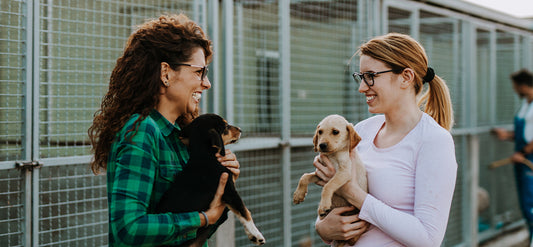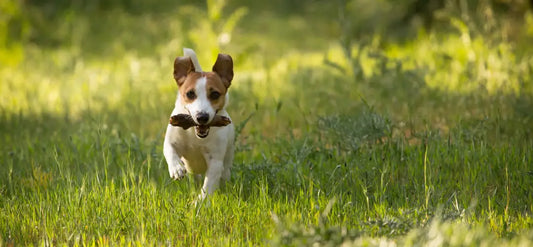Introduction
Pet obesity is one of the reasons causing many health issues among pets, especially your dogs. Dogs and cats are popular pets in our country. Overweight or obese dogs are not rare to find. According to a survey conducted in 2018 by The Association of Pet Obesity Prevention, about 56% of dogs in the US are overweight or obese.
This is alarming news for pet owners. It may be hard to make your dog’s lose weight but by proper diet and exercise to prevent and reduce weight gain. Let us deep-dive to know various aspects of pet obesity and know about the best ways to maintain a healthy weight for your dogs
What is Obesity in Dogs?
The experts suggest that it is essential to maintain a balance between the lean body weight of the dogs and their fat. If a dog weighs 10% to 20% more than the recommended body weight (Usually 70-80 lbs in an adult, average dog), it is considered overweight.
To make it simple, if your dog’s body weight causes extra strain on its heart, bones, and other important organs, it is suffering from the condition of obesity. Obese dogs face many difficulties in their daily activities due to this extra padding.
However, it is vital to ask your veterinarian to examine your dog before deciding as it is overweight because several factors are influencing the concept of obesity, such as Body Condition Score (BCS), Body Fat Percentage, Weight of the dog as per its age, gender, breed, and many more.
What is Body Condition Score among Dogs?
Body Condition Score is a number given to your pet dog based on the evaluation of fat at some key location in your dog’s body. Obviously, a veterinarian would be well-versed in conducting this kind of diagnostic study. However, pet owners can measure the BCS of their dog before or between the scheduled veterinary examination.
How to Make Out if Your Dog is Overweight or Obese based on the BCS? Does that Help in Attaining Ideal Body Weight?
As discussed above, you need to evaluate the fat at some key locations in your dog’s body. Ideally, if your dog is overweight, it would have grown extra pounds at the following locations:
Ribs
To make it simple, you should easily feel your dogs’ ribs with your flat fingers or fingertips. If so, the BCS of your dog may be 5 to 6 out of 9. If you need to struggle to find the ribs, the BCS should be 6 or 7 out of 9. If you cannot find the ribs at all, the BCS would be 8 to 9 out of 9.
Waist
You should be able to find the waist of your dog when it is wet. The ‘tuck’ where the chest ends should be easily visible from the sides. This ‘tuck’ should be going up towards the hip. If not, you need to prioritize the weight loss of your dog.
Hips
You should easily feel the points of the hips. If you can see the hip bones without any muscle on them, then your dog is too thin.
In this way, you can examine any excess fat on the key parts of your dog’s body. This physical analysis would help you determine the BCS of your dog.
What Health Issues May Be Caused Due to Obesity in Dogs?
Practically, most pet dogs lack adequate physical activity to burn calories. Similarly, there are limitations to the time a pet parent can spend with them, as pet parents work regularly. Responsible pet parents should understand the importance of regularly engaging their dogs in exercise, play, and training activities.
Extra fat may deteriorate a dog’s health and longevity in many ways. Overweight dogs get an increased risk of the following serious health problems:
- Diabetes The amount of food intake and lack of exercise regularly may cause diabetes type 2 among dogs.
-
High Blood Pressure
Overweight dogs may fall prey to high blood pressure. - Hypertension Obesity might cause hypertension.
- Heart Disease The extra pounds bear an adverse impact on the heart of your dogs. Your overweight dogs may get heart disease.
- Arthritis Osteoarthritis can develop which makes joints deteriorate faster.
- Urinary Bladder Stones If you do not control your dogs’ weight, the extra weight may lead to issues associated with kidney and bladder, like bladder stones.
- Anesthetic Complications As per a study conducted by Pet Health Network, obesity may cause aesthetic complications among dogs. As the lungs and heart are overweight, dogs struggle to breathe during anesthesia. Extra weight also causes sleeping issues.
- Tumors Obesity in dogs increases the risk of lipomas (fatty tumors) and cancers related to the breast or bladder.
- Skin Diseases The additional folds in the skin of overweight dogs may irritate due to bacterial infections. This infection may also cause body odor, excessive scratching, and skin redness.
- Problems Associated with Quality of Life When your dog is overweight, it may be less physically active or playful. Lethargy and other related issues prevail, creating behavioral issues.

How to Prevent Pet Obesity?
Determining and adopting a practical action plan to help your dog lose weight is a challenging task. Expert veterinary advice plays a crucial role here. Another most significant aspect is managing the pet food and taking meaningful steps for regularly exercising your dogs. Here are a few initiatives you should take:
-
Provide Balanced Meals with Appropriate Calories
When we say a balanced diet, you should mind the calorie intake of your furry pal every day. The food you provide should contain all the necessary nutritional ingredients to nourish your dog. You should never make your dogs starve. However, your dog needs to eat only up to a required calorie count. Plan the pet foods, treats, and supplements accordingly.
-
Schedule Your Dog’s Meals
It is important to set a routine schedule for your dog’s meals and maintain the timings. This way they learn when they are supposed to eat. Thus, you can keep the risk of obesity away.
-
Encourage Your Dogs to Work for Foods
Encouragement to work is not about mandating your dog to some task before taking food. The best way is to use some feeding toys. The feeding toys are designed to make the dogs exercise to get their food or treats. Thus, you can feed your dogs in a fun-filled way.
-
Regular Exercise is a Must
Exercising your dog helps you balance the calories your dog takes and spends through physical activity. Make a habit of dog walking and develop a place in the exteriors of your home where your dog gets moving. Dog parks would also be the best places to spend quality time with your dog. You can train your dog, help it exercise, and burn some calories there.
-
Try Toys that Encourage Exercising
Your dog should not consider the exercising schedule as a compulsion or a punishment. Rather it should be eager to exercise as per the schedule. You can achieve this by providing some innovatively designed toys that ‘inspire’ your dogs to exercise.
How Can Veterinarians Help in Preventing and Treating Pet Obesity?
A preventive health checkup by making an appointment with a professional veterinarian helps you keep your pet’s health intact. Along with many other tests, the vets and pet nutritionists also determine the BCS of your pet. If your pet is obese or has any medical condition caused due to obesity, your vet can initiate treatment at the right time to avoid further consequences.
Find the best-rated vets, veterinary clinics, and well-equipped hospitals by logging on to GreatVet.com today. The reputed vet database allows you to search for vets and specialists in your area and fix an appointment through some clicks on any browser-enabled device.
Veterinary advice is crucial to design a customized weight loss program, considering your pet’s breed, age, weight, BCS, and many other factors. A veterinary nutritionist treats pet obesity with a multidimensional approach. Let us glance at the possible action plan a pro vet may suggest helping your dog lose weight
The veterinary medical team can assess the BCS of your dog in almost every visit. Accordingly, the vet suggests a diet chart to help you feed the correct food with appropriate calories. Along with the diet plan, the vet can also help you with the estimated ideal body weight to consider during the weight loss program.
Another aspect the vet focuses on is the workout schedule for your dog to attain a healthy weight. Vets suggest exercises and also help you design a schedule for exercise to balance and burn extra fat. These inputs play a vital role in the weight loss journey of your pet. So, find the best vets near me today and take your dog for a detailed checkup.
The Takeaway
The article covers various aspects of pet obesity and discusses practical ways to help your obese dogs lose weight. A pro veterinarian can guide you through the best ways to provide a happy and healthy life for your furry friend. Get a diet and exercise plan from a vet and follow it to prevent obesity in your dogs.



